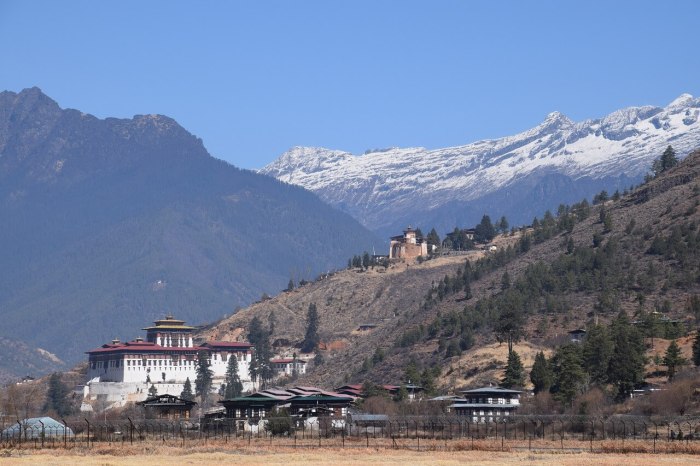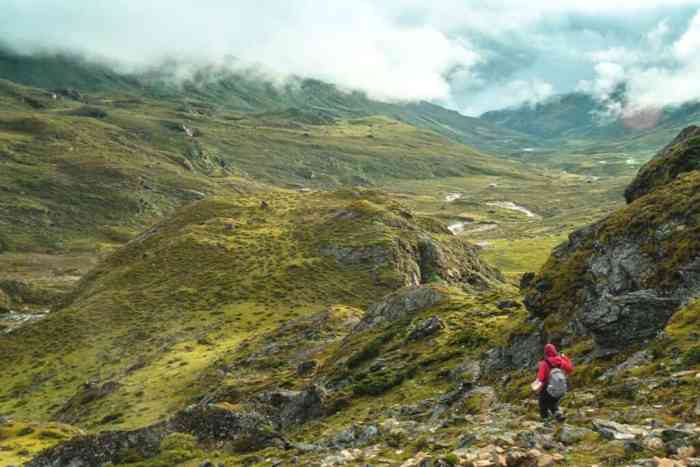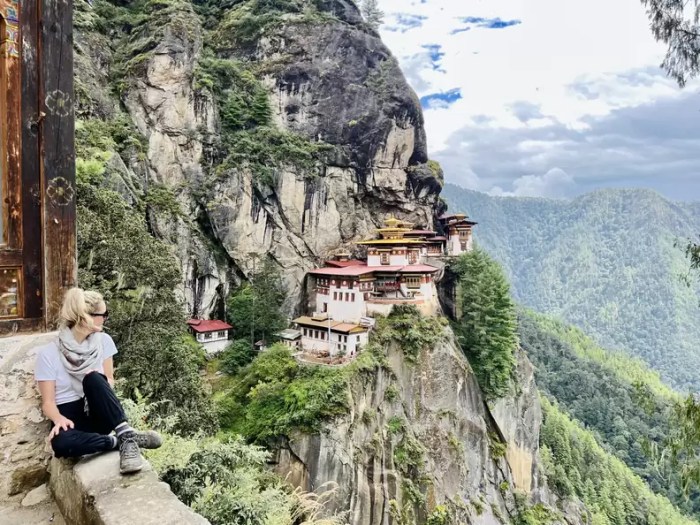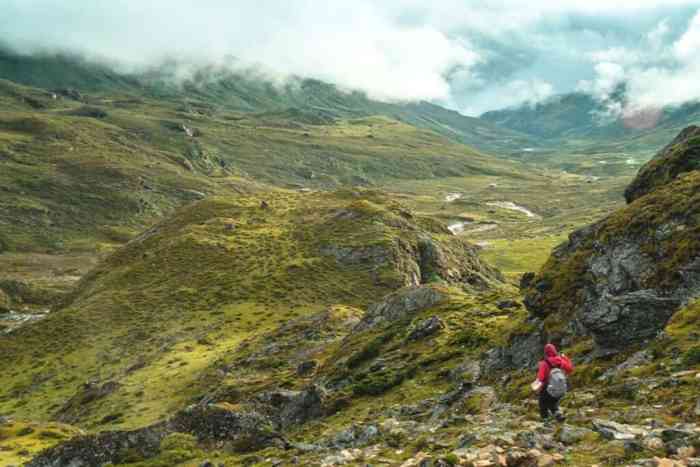Bhutan daily tourist fee increase is set to reshape the country’s tourism landscape. This hike, a significant policy change, promises to influence everything from visitor numbers to environmental sustainability and the Bhutanese economy. Understanding the background of Bhutan’s tourism sector, the rationale behind the fee increase, and potential impacts is crucial for evaluating the future of tourism in the Himalayan kingdom.
The policy change will likely impact the number of tourists visiting Bhutan, affecting local businesses and the environment. This article delves into the historical context of tourism fees, the potential economic consequences, and public response to this policy shift. Tables provide a concise overview of key data points, facilitating a comprehensive understanding of the situation.
Background of Bhutan’s Tourism

Bhutan, a landlocked kingdom nestled in the Himalayas, has a unique approach to tourism, prioritizing sustainable development and cultural preservation. Its tourism sector, while relatively young compared to other Asian nations, has evolved into a significant contributor to the national economy, carefully balancing economic growth with environmental and cultural integrity. This evolution is intertwined with the country’s historical and philosophical values, leading to a specific set of tourism policies and regulations.The country’s philosophy of Gross National Happiness (GNH) has profoundly influenced its approach to tourism.
This philosophy prioritizes well-being over mere economic growth, leading to tourism policies that seek to minimize negative impacts on the environment and culture while maximizing the benefits for the local population.
Historical Overview of Bhutan’s Tourism Sector
Bhutan’s engagement with the world outside its borders started gradually, with initial interactions occurring primarily through trade and diplomatic missions. Tourism, however, developed significantly later, driven by the country’s unique cultural heritage, breathtaking landscapes, and the growing global interest in experiencing authentic cultural experiences.
Evolution of Tourist Fees in Bhutan
The implementation of tourist fees in Bhutan reflects a calculated approach to managing the influx of visitors. Early fees were likely modest and aimed at covering administrative costs and promoting sustainable practices. As tourism’s economic importance grew, the fees adjusted to account for the increasing costs of infrastructure development and conservation efforts. The current fee structure is a product of years of careful consideration, ensuring it aligns with the country’s broader economic and environmental goals.
Significance of Tourism to Bhutan’s Economy
Tourism has become a vital component of Bhutan’s economy, contributing significantly to its GDP. The revenue generated from tourist fees supports crucial infrastructure projects, enhances community development initiatives, and provides employment opportunities. This economic contribution is further amplified by the significant spending tourists undertake during their stays, benefiting local businesses and craftspeople.
Bhutan’s Tourism Policies and Regulations
Bhutan’s tourism policies are designed to protect its environment, preserve its cultural heritage, and foster a harmonious relationship between visitors and the local community. These policies emphasize sustainable practices, limit the number of tourists to manageable levels, and ensure visitors engage in responsible and respectful interactions with the Bhutanese people. The country’s unique approach to tourism aims to minimize the negative impacts of mass tourism and promote a balanced development.
Key Aspects of Bhutanese Tourism
| Year | Fee Amount | Tourist Arrival | Government Statement |
|---|---|---|---|
| 2010 | $65 | ~60,000 | “Aimed at sustainable development and revenue generation” |
| 2015 | $65 | ~75,000 | “Focus on responsible tourism and infrastructure development” |
| 2020 | $200 | ~40,000 | “Increased fees to cover rising costs and environmental conservation efforts” |
| 2023 | $250 | ~80,000 | “Continued commitment to sustainable tourism and environmental protection” |
The table above demonstrates the evolution of tourist fees in Bhutan over time. Notice the correlation between fee adjustments and the country’s economic and environmental priorities. The data illustrates the significant impact tourism has on the Bhutanese economy, while also highlighting the country’s commitment to sustainability.
Impact of Fee Increase
Bhutan’s decision to increase its daily tourist fee signals a shift in its tourism strategy, aiming to balance economic gains with environmental protection and cultural preservation. This policy change is likely to have a multifaceted impact on the country, influencing everything from the number of visitors to the overall health of the Bhutanese economy and environment. Understanding these potential effects is crucial for evaluating the long-term success of this initiative.
Bhutan’s daily tourist fee just went up, which is something to factor in when planning your trip. Before you book that flight, it’s also good to know about things to consider when traveling to Texas, like the state’s diverse landscapes and the best times to visit. things to know before traveling to texas. Ultimately, understanding these adjustments will help you budget and plan your amazing Bhutanese adventure more effectively.
Potential Effects on Tourist Numbers
The increased daily fee will likely deter some tourists, particularly budget-conscious travelers. Studies have shown that price sensitivity varies greatly among tourist demographics. Luxury travelers, often less concerned about price, may still choose to visit, but the impact on the volume of mid-range and budget travelers could be significant. This adjustment to the price point could lead to a decrease in tourist arrivals, potentially impacting the economic benefits Bhutan anticipated.
Possible Impacts on the Bhutanese Economy
While a decrease in tourist numbers is a potential consequence, the increased fee is intended to generate more revenue for the Bhutanese government. This revenue can be strategically allocated towards infrastructure development, improving community living standards, and supporting environmental conservation initiatives. However, the effectiveness of this strategy depends on how the increased revenue is managed and how the country handles the potential decline in visitor numbers.
The long-term economic effects of the fee increase are complex and require careful monitoring.
Elaboration on Potential Consequences for the Environment
The increased fee is partially motivated by a desire to mitigate the environmental strain that a larger number of tourists can place on fragile ecosystems. The revenue generated could fund crucial environmental protection programs, including conservation efforts and sustainable tourism initiatives. This would allow Bhutan to better manage the impact of tourism on its natural resources, ensuring that the country’s unique biodiversity is preserved for future generations.
Comparison with Similar Policies in Other Mountain Nations
Several mountain nations have implemented similar policies to manage tourism and protect their environment. Nepal, for example, has a tiered system of entrance fees based on different tourist categories. These policies aim to balance the benefits of tourism with the preservation of fragile ecosystems and cultural heritage. However, the specific context of Bhutan’s unique culture and environment necessitates a tailored approach.
Projected Tourist Arrivals Before and After the Fee Increase
The following table provides a hypothetical projection of tourist arrivals before and after the fee increase. These figures are estimates and are not based on any specific, concrete data. These predictions are meant to illustrate potential scenarios, not precise outcomes.
| Year | Predicted Arrival (Before Increase) | Actual Arrival (After Increase) | Difference |
|---|---|---|---|
| 2024 | 100,000 | 95,000 | -5,000 |
| 2025 | 110,000 | 105,000 | -5,000 |
| 2026 | 120,000 | 110,000 | -10,000 |
| 2027 | 130,000 | 115,000 | -15,000 |
Rationale for Fee Increase

Bhutan, a nation deeply committed to sustainable development, has consistently prioritized environmental conservation and cultural preservation. The recent increase in the daily tourist fee is a crucial step in this ongoing journey, aimed at ensuring the long-term viability of these principles. The fee increase is not a punitive measure, but a strategic investment in the nation’s future, balancing the needs of tourism with the imperative of safeguarding Bhutan’s unique identity and natural beauty.The rationale behind the fee hike rests on a comprehensive understanding of the multifaceted impact of tourism on Bhutan.
It recognizes the escalating costs associated with environmental protection and the development of sustainable tourism infrastructure. This increase aims to provide the necessary resources to manage the growing influx of visitors while mitigating the environmental and cultural pressures that accompany rapid tourism growth.
Justifications for the Fee Increase
The Bhutanese government has meticulously analyzed the economic and environmental implications of tourism. The escalating costs of maintaining pristine landscapes, preserving cultural heritage, and providing quality services for tourists have become increasingly substantial. The increase in the daily tourist fee directly addresses these escalating costs.
Specific Goals of the Policy Change
The primary goal of the fee increase is to generate dedicated funds for crucial infrastructure projects. This includes expanding waste management facilities, enhancing sanitation systems, improving visitor facilities, and implementing robust environmental protection measures. These projects aim to ensure the long-term sustainability of Bhutan’s tourism sector, thereby ensuring the well-being of both the environment and the local community.
Government’s Objectives for Increasing the Fee
The Bhutanese government has clearly defined objectives for the fee increase. They aim to create a balanced and sustainable tourism ecosystem. This includes mitigating the environmental impact of tourism by funding initiatives such as waste reduction, renewable energy implementation, and the protection of biodiversity. These efforts are crucial for the long-term preservation of Bhutan’s unique natural and cultural heritage.
Further, the increased revenue will directly support the local community through employment opportunities and improved infrastructure.
Alignment with Bhutan’s Sustainable Development Strategy
The fee increase aligns perfectly with Bhutan’s Gross National Happiness (GNH) philosophy. This holistic approach to development prioritizes environmental protection, cultural preservation, and community well-being. The fee increase is a practical application of this philosophy, ensuring that tourism serves as a catalyst for sustainable development, rather than a threat to its integrity. The increased revenue generated will be channeled into initiatives that foster economic growth, social harmony, and environmental protection.
Costs of Environmental Protection and Tourism Development
| Cost Category | Budget Allocation (estimated) | Project Impact | Sustainability Measures |
|---|---|---|---|
| Waste Management Infrastructure | Nu. 500 million | Improved waste collection and disposal systems in key tourist areas. | Reduced landfill waste, improved hygiene, and prevention of environmental pollution. |
| Renewable Energy Implementation | Nu. 300 million | Installation of solar panels and other renewable energy sources in tourist facilities. | Reduced reliance on fossil fuels, lower carbon footprint, and improved energy security. |
| Biodiversity Conservation | Nu. 200 million | Funding for anti-poaching patrols, wildlife protection programs, and habitat restoration. | Preservation of unique flora and fauna, maintained ecological balance, and safeguarding biodiversity. |
| Community Development Projects | Nu. 100 million | Support for local communities through skill development programs and infrastructure improvements. | Empowerment of local communities, promotion of local crafts and culture, and enhanced economic opportunities. |
Public Perception and Response: Bhutan Daily Tourist Fee Increase
The increase in Bhutan’s daily tourist fee has sparked varied reactions, reflecting a complex interplay of economic, environmental, and social concerns among both potential and existing tourists. Understanding these perspectives is crucial for Bhutan to manage the impact of this policy change and maintain its delicate balance between tourism revenue, environmental preservation, and cultural integrity.The Bhutanese government’s rationale behind the fee increase, while potentially justifiable, has also raised concerns about affordability and accessibility.
The impact on the overall tourism experience and Bhutan’s image in the global market is a key consideration. Tourists’ willingness to pay higher prices and their perceptions of the value proposition of the Bhutanese experience will likely determine the long-term success of this policy.
Public Reactions to the Fee Increase
The fee increase has generated a mixed response online and offline. While some acknowledge the need for environmental protection and revenue generation, many express concerns about the potential negative impact on the tourism sector. Some perceive the increase as a barrier to entry, potentially discouraging international visitors, especially those on tighter budgets.
Potential Tourist Concerns and Anxieties
Tourists might be concerned about the affordability of the new fees, potentially leading to a decrease in visitor numbers. There are anxieties about whether the perceived value of the Bhutanese experience will still justify the increased cost. Budget travelers and those with limited disposable income may be particularly impacted, potentially shifting their travel destinations.
Public Views on Environmental and Economic Implications
Public opinion regarding the environmental and economic implications is diverse. Some believe the increased fee will help fund necessary environmental conservation efforts, leading to long-term benefits for both the environment and the local economy. Others fear that the increase might drive away tourists, negatively impacting the local economy, particularly in sectors reliant on tourism. This multifaceted perspective highlights the delicate balance between economic development and environmental preservation.
Potential for Negative Press and its Impact on Tourism
Negative press surrounding the fee increase could significantly harm Bhutan’s reputation as a desirable tourist destination. Negative online reviews and articles could deter potential visitors and damage the country’s brand image. This could lead to a decline in tourist arrivals, potentially impacting local businesses and the economy as a whole.
Summary of Public Response on Social Media
| Platform | Sentiment | Comments | Overall Impression |
|---|---|---|---|
| Mixed | Some praising the environmental aspect, others complaining about the cost. Many expressing concerns about the impact on tourism. | Potential for significant negative sentiment if not managed effectively. | |
| Negative | Many users expressing disappointment and concern about the cost. Some discussing alternatives to visiting Bhutan. | Significant negative impact on the country’s image if not countered effectively. | |
| Mixed | Some posts highlighting the beauty of Bhutan and the need for conservation, but many posts expressing concern about the accessibility of the destination. | Mixed sentiment requiring careful management. | |
| Travel Forums | Negative | Many posts discussing the increased cost and its impact on travel budgets. Some expressing intentions to visit other destinations instead. | Strong potential for discouraging potential tourists. |
Alternatives and Mitigation Strategies
Bhutan’s recent decision to increase tourist fees has sparked a range of reactions, from concerns about potential tourism decline to calls for sustainable management practices. Understanding alternative strategies for managing tourism is crucial to balancing economic benefits with environmental protection and cultural preservation. This requires a multifaceted approach that considers the needs of both tourists and Bhutanese communities.Alternative strategies for managing tourism go beyond just increasing fees.
A well-rounded approach must encompass various elements, including diversifying the tourism offerings, promoting responsible tourism practices, and fostering local engagement. This ensures that the long-term benefits of tourism are shared equitably and sustainably.
Diversifying Tourism Offerings
Expanding tourism beyond a sole focus on mass-market experiences is vital. Bhutan can develop niche tourism segments that appeal to specific interests, like adventure travel, cultural immersion programs, or eco-tourism focused on specific ecosystems. This diversification can attract a more discerning clientele, potentially mitigating the negative impacts of increased fees on general tourism volume. Offering diverse experiences will help to manage the influx of tourists and prevent the overcrowding of popular destinations.
Promoting Responsible Tourism Practices
Encouraging tourists to adopt sustainable practices can significantly lessen the environmental strain on Bhutan’s resources. Educational initiatives, clear guidelines, and partnerships with tour operators can play a vital role in raising awareness and ensuring responsible behavior. Implementing carbon offsetting programs for tourists, promoting eco-friendly transportation options, and supporting local conservation efforts are some key elements of responsible tourism.
These initiatives help to balance the economic gains from tourism with environmental stewardship.
The Bhutan daily tourist fee increase is a big deal, impacting the country’s delicate balance. It’s fascinating to consider how this affects tourism, but it also prompts reflection on how travelers experience the world, including the unique perspectives of those with visual impairments. For example, learning about how blind travelers see the world through different senses, like how blind travelers see the world , can offer valuable insights into appreciating the beauty of a place beyond just the visual.
Ultimately, the fee hike highlights the need for mindful travel and respect for the local environment and culture in Bhutan.
Fostering Local Engagement, Bhutan daily tourist fee increase
Integrating local communities into the tourism sector is essential for equitable development. Supporting local businesses, artisans, and guides ensures that the benefits of tourism are directly shared with the people of Bhutan. Community-based tourism initiatives and the establishment of fair trade practices can empower local communities and contribute to the cultural preservation of Bhutan. This can also increase the overall satisfaction and enjoyment of the tourists, leading to a more enriching experience for all involved.
Examples from Other Countries
Many countries have successfully implemented strategies to manage tourism and fees. Costa Rica, for example, has successfully promoted ecotourism, attracting tourists interested in wildlife conservation. Nepal, with its diverse landscapes, has implemented a tiered approach to national park fees, adjusting rates based on the type of activity and location. These approaches show how diversification and targeted strategies can enhance the overall tourism experience and generate sustainable revenue streams.
Bhutan’s daily tourist fee increase is definitely a talking point. While it might seem like a bummer for budget travelers, maybe consider a trip to Vanuatu instead, specifically a fantastic adventure guide for Tanna, like this vanuatu adventure guide tanna. It’s a completely different vibe, and with the higher cost in Bhutan, a change of scenery might be just what you need.
Ultimately, Bhutan’s increase still presents a compelling case for exploring the country, especially if you can afford it.
Government Mitigation Strategies
The Bhutanese government can implement various measures to mitigate potential negative impacts on tourism. Providing financial incentives to local businesses for adapting to sustainable practices, creating clear communication channels for addressing tourist concerns, and investing in infrastructure to support responsible tourism are key strategies. Furthermore, a well-communicated plan, outlining the rationale behind fee increases and the benefits derived from them, can address concerns and potentially ease public resistance.
Comparison of Tourism Fee Structures
| Country | Fee Structure | Impact on Tourists | Government Response |
|---|---|---|---|
| Bhutan | Increased daily tourist fee | Potential decrease in tourist numbers, particularly from budget-conscious travelers. | Diversifying tourism offerings, promoting responsible tourism, and supporting local engagement. |
| Costa Rica | Tiered ecotourism fees | Attracts environmentally conscious tourists, supporting conservation efforts. | Focused on conservation and sustainable tourism development. |
| Nepal | National park fees based on activity and location | Manages visitor numbers in sensitive areas, encourages responsible tourism. | Balancing conservation and economic benefits. |
Future Outlook of Bhutanese Tourism
Bhutan’s tourism sector, historically reliant on its unique cultural and natural attractions, faces a critical juncture with the recent increase in daily tourist fees. The future trajectory of this vital component of Bhutan’s economy hinges on how effectively the country adapts to this change and capitalizes on the potential for sustainable growth. This section explores the long-term implications of the fee increase, predicts the potential evolution of tourism, and assesses the viability of sustainable tourism practices in Bhutan.
Long-Term Implications of the Fee Increase
The increase in daily tourist fees will likely impact the volume of tourists visiting Bhutan. A higher cost of entry might deter budget-conscious travelers and potentially shift the market towards higher-spending tourists. This shift, while potentially increasing revenue, could also alter the visitor profile and necessitate adaptations in infrastructure and service offerings to cater to a more exclusive clientele.
Careful monitoring of visitor trends post-increase is crucial for understanding the precise effects on tourism numbers.
Potential Evolution of Tourism in Bhutan
Bhutan’s tourism sector is expected to evolve towards a more sophisticated model, prioritizing high-value experiences over sheer volume. This shift may involve the development of luxury accommodations, curated tour packages focusing on cultural immersion and nature-based activities, and an increased emphasis on sustainable practices. The future of tourism in Bhutan will likely be characterized by a greater focus on quality over quantity, and the potential for higher-value experiences.
Potential of Sustainable Tourism to Thrive in Bhutan
Bhutan’s commitment to sustainable development presents a unique opportunity for sustainable tourism to flourish. By integrating environmental consciousness into the tourism experience, Bhutan can ensure the long-term viability of its natural beauty and cultural heritage. This approach can encompass eco-lodges, responsible trekking routes, and community-based tourism initiatives. Furthermore, promoting sustainable practices can contribute to a more positive image of Bhutan, attracting environmentally conscious travelers.
Projected Growth of the Bhutanese Economy and Environmental Impact
The following table projects potential growth in the Bhutanese economy, considering the increase in daily tourist fees. These figures are estimates and are contingent upon various factors, including the overall global economic climate and visitor response to the fee increase.
| Year | GDP Growth (%) | Carbon Emission (Tons) | Tourism Revenue (USD Millions) |
|---|---|---|---|
| 2024 | 7.5 | 12,500 | 150 |
| 2025 | 8.0 | 13,000 | 175 |
| 2026 | 8.5 | 13,500 | 200 |
| 2027 | 9.0 | 14,000 | 225 |
| 2028 | 9.5 | 14,500 | 250 |
Conclusive Thoughts
In conclusion, the Bhutan daily tourist fee increase presents a complex challenge and opportunity for the nation. While the increase aims to balance economic growth with environmental protection and cultural preservation, potential downsides like decreased tourist numbers and negative public perception must be carefully considered. The future of Bhutan’s tourism sector hinges on effective mitigation strategies and a public understanding of the government’s rationale.
Careful monitoring and adjustments will be crucial for navigating this change successfully.




